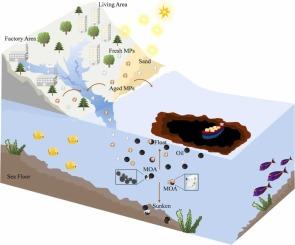微塑料类型和老化程度对海洋溢油运移行为的影响
IF 11.3
1区 环境科学与生态学
Q1 ENGINEERING, ENVIRONMENTAL
引用次数: 0
摘要
海洋石油泄漏和微塑料污染对当前海洋环境构成双重威胁。然而,研究人员对不同类型的MPs如何影响石油泄漏的运输行为的关注有限。本研究评估了四种不同程度紫外线老化的常见MPs对溢油行为的影响,重点研究了它们在MPs-oil团聚体(MOA)形成、石油分散和沉积中的作用。MPs和油主要通过疏水性和范德华力的相互作用发生团聚。紫外线老化降低了MPs与油之间的团聚程度。老年MPs含氧官能团增多,负电位增大。这些特性增强了静电斥力,同时降低了疏水和范德华相互作用。老化的MPs促进了油的分散,油的分散效率提高了6.6 ~ 13.7%,同时抑制了油的沉积。MPs的类型和老化程度显著影响其与原油的相互作用,进而影响原油在水柱中的运移行为。这些发现有助于科学评估MPs在溢油迁移过程中的作用以及复杂污染物对海洋生态系统的潜在威胁。本文章由计算机程序翻译,如有差异,请以英文原文为准。

Impact of microplastic types and aging degrees on the transport behavior of marine oil spills
Marine oil spills and microplastics (MPs) pollution pose dual threats to the current marine environment. However, researchers have paid limited attention to how different types of MPs affect the transport behavior of oil spills. This study evaluated the impact of four common MPs with varying degrees of UV aging on oil spill behavior, focusing on their roles in the formation of MPs-oil agglomerates (MOA), oil dispersion and sedimentation. MPs and oil primarily undergo agglomeration through interactions between hydrophobic and van der Waals forces. UV aging reduced the degree of agglomeration between MPs and oil. The aged MPs had more oxygen-containing functional groups and more negative potential. These properties enhanced electrostatic repulsion while decreasing hydrophobic and van der Waals interactions. Aged MPs promoted oil dispersion, and the oil dispersion efficiency increased by 6.6-13.7% while inhibiting oil sedimentation. The types and aging degrees of MPs were found to significantly affect their interaction with the oil, which further affected the transport behavior of oil spills in the water column. These findings could facilitate scientific evaluation of the role of MPs in the oil spill migration process and the potential threat of complex pollutants to the marine ecosystem.
求助全文
通过发布文献求助,成功后即可免费获取论文全文。
去求助
来源期刊

Journal of Hazardous Materials
工程技术-工程:环境
CiteScore
25.40
自引率
5.90%
发文量
3059
审稿时长
58 days
期刊介绍:
The Journal of Hazardous Materials serves as a global platform for promoting cutting-edge research in the field of Environmental Science and Engineering. Our publication features a wide range of articles, including full-length research papers, review articles, and perspectives, with the aim of enhancing our understanding of the dangers and risks associated with various materials concerning public health and the environment. It is important to note that the term "environmental contaminants" refers specifically to substances that pose hazardous effects through contamination, while excluding those that do not have such impacts on the environment or human health. Moreover, we emphasize the distinction between wastes and hazardous materials in order to provide further clarity on the scope of the journal. We have a keen interest in exploring specific compounds and microbial agents that have adverse effects on the environment.
 求助内容:
求助内容: 应助结果提醒方式:
应助结果提醒方式:


